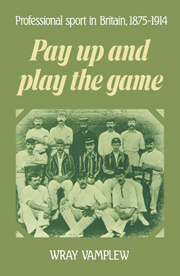Book contents
- Frontmatter
- Contents
- List of tables
- Preface
- Acknowledgements
- A guide to prices, 1870–1914
- Part I An overview
- Part II The development of professional gate-money sport
- 3 Popular recreation before the Industrial Revolution
- 4 Sporting activities and economic change, 1750-1830
- 5 The precursors of commercialised sport, 1830–75
- 6 The rise of professional gate-money sport, 1875–1914
- 7 From sports spectator to sports consumer
- Part III Sport in the market place: the economics of professional sport
- Part IV Playing for pay: professional sport as an occupation
- Part V Unsporting behaviour
- Part VI A second overview
- Appendices
- Notes
- Bibliography
- Index
4 - Sporting activities and economic change, 1750-1830
Published online by Cambridge University Press: 16 February 2010
- Frontmatter
- Contents
- List of tables
- Preface
- Acknowledgements
- A guide to prices, 1870–1914
- Part I An overview
- Part II The development of professional gate-money sport
- 3 Popular recreation before the Industrial Revolution
- 4 Sporting activities and economic change, 1750-1830
- 5 The precursors of commercialised sport, 1830–75
- 6 The rise of professional gate-money sport, 1875–1914
- 7 From sports spectator to sports consumer
- Part III Sport in the market place: the economics of professional sport
- Part IV Playing for pay: professional sport as an occupation
- Part V Unsporting behaviour
- Part VI A second overview
- Appendices
- Notes
- Bibliography
- Index
Summary
Beginning in the mid eighteenth century the British economy underwent a structural transformation as industry came more into prominence. In turn industrialisation had an impact on popular recreation as it called for new work patterns. Admittedly, hard and sustained effort had been demanded by agriculture at harvest time, but in industry, particularly factory industry, the pressure was less seasonal and more unrelenting. What was required in industry was regular hours and, above all, long hours. Unit overhead costs could only be reduced if the growing volume of machinery and other capital equipment was intensively employed, particularly as in some industries the initial physical productivity gains of the new methods of production over the old were not significantly large. Even in industries which were relatively unmechanised economies could be obtained by task specialisation and labour synchronisation. Admittedly, with work being collected at long intervals, there was enough slack in the domestic system to tolerate members of the production chain working different hours, but, where the work force was more concentrated, embryo assembly lines could often be operated and, for such a cooperating or integrated labour force, productivity was much higher when they worked the same hours.
It was no easy task to persuade a labour force to accept the new work discipline. Indeed initially it was difficult enough to get workers into the factories at all. Not only was working from dawn to dusk, six days a week, virtually throughout the year, alien to traditional work patterns but, for many, industrial employment would involve geographical as well as occupational mobility.
- Type
- Chapter
- Information
- Pay Up and Play the GameProfessional Sport in Britain, 1875–1914, pp. 33 - 43Publisher: Cambridge University PressPrint publication year: 1988



